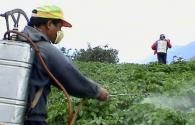At-A-Glance Views

Though some pesticides toxic to humans, other animals and the environment have been banned from use, implementation of the bans is inconsistent, and illegal use still occurs. In addition, other highly hazardous pesticides are also in current use around the world.
Pesticides, chemical preparations for destroying plant, fungal, or animal pests, have been used, at least on a small scale, since ancient times. Arsenic was used as a pesticide by ancient Greeks and Romans, and there are reports that the Chinese were using arsenicals as pesticides as early as the sixteenth century. In the late nineteenth century, arsenic compounds came into widespread use as insecticides in Europe and North America and this led to the world’s first pesticide legislation in 1900. It was not until the 1930s, however, that synthetic chemical pesticides were introduced. Then, following the Second World War, synthetic chemical pesticides and fertilizers started to be produced and used on a very large scale. This resulted in initial dramatic increases in crop yields, and as a result, the use of pesticides and other agrochemicals spread rapidly. One consequence was to expand crop production in developing countries for sale in industrialized countries. Another was the rise of monocropping: planting the same crop every year, without crop rotation and without resting the soil.
With increasing use of pesticides, many of the targeted pests began developing resistance. This often led growers to use heavier doses to control them. Frequently, the pesticides killed not only the targeted pest, but also beneficial species. This led to a new phenomenon called secondary pest outbreaks: insects or mites that had been previously controlled by beneficial species, and that often went unnoticed, began to appear in epidemic numbers. New pesticides were then introduced to control the secondary pests and the total quantities of pesticides being used continued to grow.
The pesticides in use harmed soil microorganisms that play a key role in helping plants utilize the soil nutrients they need to grow and thrive. They often spread on air currents, contaminating surrounding areas, and disrupting populations of birds, mammals, fish and other species. Pesticide run-off into surface and groundwater systems began to compromise human drinking water supplies. By the mid-1950s, numerous researchers were documenting these and other problems associated with the use of pesticides.
In recent years, the term highly hazardous pesticide or HHP has been expanded and is now used to describe not only acutely toxic pesticides but also pesticides that cause serious chronic health effects. It is generally much more difficult to demonstrate chronic health effects than it is to demonstrate acute toxic effects, but important research is ongoing. When there is a weight of evidence that links a pesticide to a serious chronic health effect, that pesticide is also considered to be an HHP. Chronic health impacts associated with pesticides include cancers and tumors, nervous system disorders, reproductive problems, immune system effects, and endocrine system disruption.
Pesticides currently included in the Stockholm Convention on Persistent Organic Pollutants (POPs) are:
- aldrin
- chlordane
- DDT
- dieldrin
- endrin
- heptachlor
- hexachlorobenzene
- mirex
- toxaphene
- chlordecone
- alpha hexachlorocyclohexane
- beta hexachlorocyclohexane
- lindane
- pentachlorobenzene
- pentachlorophenol and its salts and esters
- technical endosulfan and its related isomers
For information about these pesticides' original uses and production, characteristics, and listings in the Convention, see the Stockholm Convention website.
Main Right Block
Debug toxic priority variant
